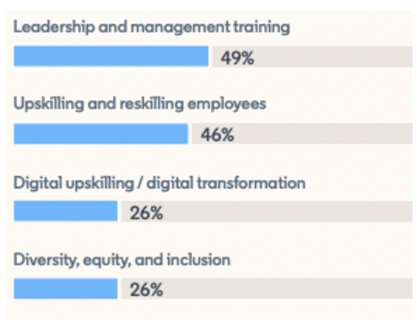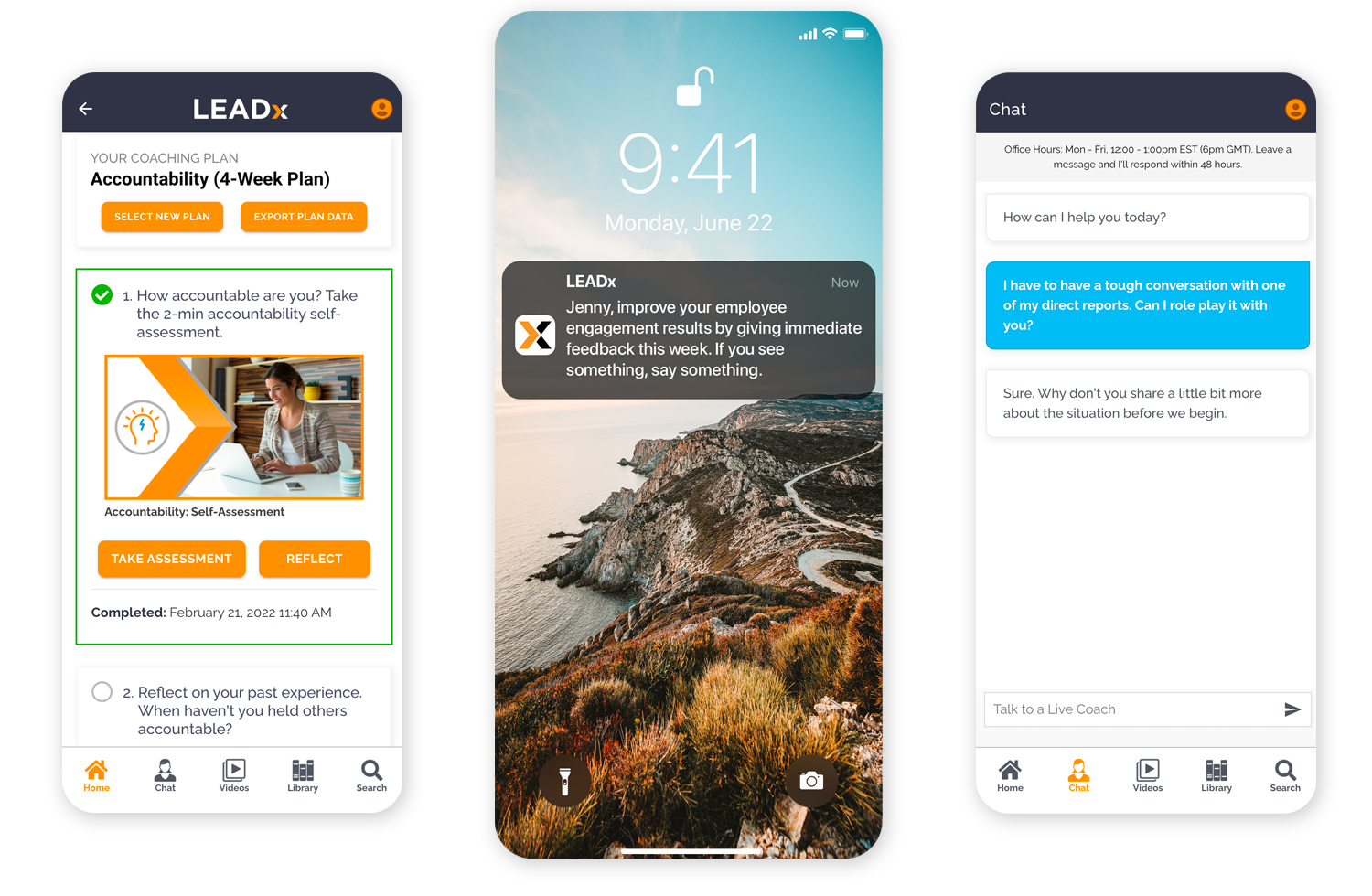
Leadership Development Program: 7 Key Qualities of Successful Programs
The LinkedIn 2022 report showed that “leadership development” was the number one priority for L&D pros in 2022.
 That’s because leaders are the backbone of company culture and employee engagement. Employees who don’t feel like their manager cares about them are nearly 50% more likely to apply for a new job. On the other hand, employees who feel their managers do care are three times as likely to report being happy at work and four times as likely to recommend their company to a friend.
That’s because leaders are the backbone of company culture and employee engagement. Employees who don’t feel like their manager cares about them are nearly 50% more likely to apply for a new job. On the other hand, employees who feel their managers do care are three times as likely to report being happy at work and four times as likely to recommend their company to a friend.
Benefits of a Great Leadership Development Program
A strong leadership development program can help you:
- Retain and Develop Talent. A great leadership development program helps your organization build a system to identify, foster, and grow their talent. It almost goes without saying, that talented employees who feel seen and fostered, and who are surrounded by other talented employees, are more likely to stay. A truly great program will even help you recruit new talent. At Kellogg’s, for example, their leadership development program was so successful that talent from other companies applied for jobs after they heard about it.
- Achieve Key Business Outcomes. Often, the best leadership development programs are built with specific business objectives in mind. As a result, the success of the program directly affects that outcome. For example, Associa is a Community Management company. They make money by keeping their clients—Community Managers—happy. To keep community managers happy, Associa focused on training their Directors. These Directors are the people that Community Managers meet with consistently to discuss policy changes, problems in their community, and more. By focusing on the leadership skills of their Directors, Associa improved retention (of Directors and business from Community Managers). They also developed a pipeline of talented employees ready to fill Director-level roles as they opened up. As a result, a full 80% of Associa’s leaders were promoted internally.
- Improve Engagement. Helping leaders become more effective should result in improved employee engagement. At NextGen Healthcare, for example, “engagement” and “leadership development” are nested together. Their employee engagement survey results and feedback drive leadership development initiatives. In turn, they measure the success of their leadership development programs by improvement in engagement. After five years, NextGen Healthcare has experienced an 18% increase in the “manager relationship” engagement driver and a 34% increase in the “culture” driver.
Full Interview With NextGen Healthcare
4 Reasons Leadership Development Programs Fail
One useful way to look at what makes for a successful leadership development program is to look at the most common reasons they fail. Each of the four points below come from an article from McKinsey. Based on their conversations about leadership development with hundreds of chief executives, they found these four recurring reasons for failed leadership development initiatives.
- Lack of Context. Leadership development efforts need to take into account things like different audiences, parts of the business, and moments in time. The skills that will elevate the performance of one leader at one time may not transfer to another audience or time. In fact, the skills likely won’t translate. The article gives an example where a highly innovative executive fails to change his strategy or approach during a recession. He continues to push innovation and is let go for low performance. The authors suggest honing in on one or two key skills that will help leaders in a specific business unit to accomplish a specific objective.
- Not Enough Application and Reflection on the Job. Offsite programs and day-long programs give leaders a chance to step away from work, bond, and build connections. But, the amount of learning that actually sticks from these programs is small. Estimates sit around 10% of learning being retained. And, this doesn’t even get into how much of that 10% is then applied on the job. When leaders apply what they learn on the job, they are much more likely to actually change their behavior. This is especially true when the application is natural and fits into the work they’re already doing.
- Trying to Change Behavior without Changing Mindset. A leader’s behaviors are heavily influenced by how they see the culture around them, their position, and their work. Leadership development programs that set out to change behaviors without first understanding the culture and mindset of the leaders, are setting themselves up to fail.
- Poor Results Measurement. Leadership development initiatives won’t be taken as seriously if they don’t measure the improvement they set out to achieve. Measurement is also the most effective way for leadership development pros to see and understand the bigger picture. What’s working and what’s not working, and how can they adjust their approach?
Further Reading:
- Why Leadership Development Programs Fail – McKinsey Article
- Why Leadership Training Fails and What To Do About It – HBR Article
What Should A Leadership Development Program Include? 7 Key Qualities
Whether you’re looking to build a program in-house or hire an outside vendor, look for the following seven qualities of a successful leadership development program. These qualities will help you overcome the four problems mentioned above. And, ultimately, these qualities will help you reap the full benefits of a highly successful program.
Each quality is based on the research around successful leadership development programs as well as on the hundreds of interviews and case examples we’ve done at LEADx.
- A Career-Long Journey. The best leadership development programs span an employee’s entire career and experience at your organization. Employees should be able to see opportunities to learn and grow from individual contributor level up to executive level. AML RightSource stood out for how deep and extensive their learner journey is. If you were to join AML RightSource, for example, they have a clearly delineated leadership development path with constant opportunities and key touchpoints during crucial transitions. Ideally, your path has “through threads” or key ideas and principles that run from frontline employees up to the top. See Quality #3 for a powerful way to build a clear “through thread.”
Full AML RightSource Interview
- Focus on Application, Not Learning. Too much emphasis is placed on “learning transfer.” In reality, just like the McKinsey article says, the best-case scenario is a measly 10% learning transfer. Instead, focus your efforts on something more impactful—behavioral change. The key to behavior change is thoughtful, on-the-job application. At LEADx, we lean on a 3-to-1 model to achieve this. It’s simple and actionable. For every one formal learning objective, you should design and facilitate at least three on-the-job application exercises. Here’s a simple example for Effective Feedback:
* Week 1: Live workshop to learn and practice
* Week 2: Participants ask team members to give THEM feedback
* Week 3: Participants give team members POSITIVE feedback
* Week 4: Participants give CONSTRUCTIVE feedback
At the end of each week, participants could submit a red/yellow/green light reflection exercise. They write “what went well, what didn't, questions, and more.”
- Establish One Core Piece of Content. A foundational piece of content can hold your key values and philosophy around leadership in one place. It can also help keep your development efforts focused on the outcomes that are most important to your organization. For example, at Intuit, they leverage one core playbook called The Intuit Playbook. The Playbook is exactly what it sounds like. Leaders can turn to the book to refresh themselves on what they need to know. The book offers strategies for action, supplemental podcasts and videos, and 1-2 page “manager guides” that show leaders what they should know and do across 35 key aspects of leadership. Each month, Intuit hosts coaching seminars where leaders present a challenge they’re facing, and the leadership development team works through the problem with them using the playbook. Other organizations lean on books, like Wix’s The Wix Way of Leadership. The idea is simple. No matter where a leader is at in their development journey, they share in common that core piece of content.
- Use Measurement to Evaluate, Re-evaluate, and Grow. Many companies look at measurement as existing in the extremes: Either overly simple (like attendance) or overly complex (like a system that requires a people analytics team). But, the reality is that there are useful and impactful ways to measure the effectiveness of your training regardless of your size, budget, or resources. Associa, for example, built their own self-assessment based on the specific competencies and behaviors they train. Participants can freely retake the self-assessment at various points in their training to check in on their progress. Sure, it’s not as complex or comprehensive as 360s, weekly pulses, and 200-question organization-wide engagement surveys. But, it’s far more effective than no measurement or overly simplified attendance measures. The key is to just get started. As measurement proves useful, and as leadership development teams and budgets grow, so can their measurement. AML RightSource started out measuring simpler things: Net Promoter Score, Perceived Effectiveness, and Retention. As their leadership development program grew, they added a much more robust measurement tool. The tool provides them with live, aggregated data based on things like employee performance, opinions, life cycle, tenure, growth, production, and attrition.
Full AML RightSource Interview
- Takes Busy Schedules into Account (Shows Value). After a client rolled out a new training program recently, they did something interesting. They surveyed everyone who chose not to participate and asked them “why not?” The top three reasons people opted out of the program were: 1) being too busy, 2) bad timing, and 3) irrelevant content. What’s interesting about the results is that, while the responses appear different, they actually all mean the same thing: “the value of this training isn’t worth my time.” If you want to increase participation, make the value as clear as possible. Make sure it 1) connects to business objectives, 2) has buy-in from employees’ leaders, and 3) is delivered in the natural flow of people’s work (using micro-learning, nudges, and short exercises.
- Leverage Peer Learning. One of the best ways to make learning constant and on-the-job is to create a system of learning that’s self-organizing. In a peer learning network, ideas spread faster, are shared with more people, and can be challenged, tested, and refined more quickly. Peer learning networks can exist in a number of ways: Slackline contests where employees share examples and tips from their experience, learn-teach-learn models where leaders share what they’ve learned to other leaders, or group coaching sessions that draw on the experiences and perspectives of everyone in the room.
Study on the Power of Mentoring
Peer Learning Networks at Catholic Health
Slack Contests at NextGen Healthcare
- Move Fast, Be Dynamic. In marketing and product development, it’s common to hear how important it is to experiment, adjust, and refine as you go. But, it’s much less common to hear that about leadership development. Many leadership development programs tend to be established and rolled out slowly for years before significant adjustments are made. For that reason, a dynamic approach can serve as a huge competitive advantage. At Nestlé, for example, they rolled out a new leadership simulation program right before the outset of covid. Covid easily could have been the end of their leadership simulation program, especially since it was designed to take place in person. Instead, they brought the program to Zoom. They leveraged Zoom to do things like: 1) bring in business leaders as role players, 2) record and analyze their simulations, 3) test the simulation at multiple locations around the world, and 4) expand the simulations to a number of businesses and locations. Their ability to move fast and adjust along the way resulted in the rapid development of one of their strongest programs.
Additional Reading:
9 Essential Tasks for Creating a Leadership Dev Program
7 Great Examples Of Leadership Development Programs
Staying Ahead: The Shifting Landscape of Leadership Development
The pandemic has fundamentally shifted how leadership development work is being done. The hybrid era actually makes many of the above qualities much easier to achieve than ever before. Nestlé wouldn’t have ever been able to scale their simulations around the world in a matter of months across business units and cultures if not for Zoom. Peer learning gains power and network status from being housed online as it is at NextGen Healthcare and Catholic Health.
This Harvard Business Review article sums up this shifting direction of leadership development well: “Training is moving beyond the week-in-a-classroom model of learning towards something more experiential and applied and partly virtual.”






